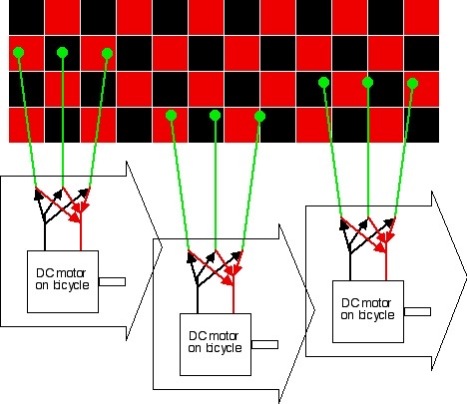So, when we run out of oil, how will we get around?
October 10, 2006
On bikes, of course, but would it hurt to have a little electrical assist?
One of the finer books that I have read is Bicycling Science . It’s astonishing how little power it takes to move a human at a moderate pace, if you dispense with the 2000 pounds of armor that we normally use for transportation. Of course, as engines go, we’re pretty wimpy, and many people will balk at riding up a serious hill, especially if they are carrying 4 bags of groceries, especially if (for whatever reason) they are not in good physical shape. If we were serious, we could supply, as part of our infrastructure, an electrical assist.
We have similar infrastructure already; overhead wires for electric busses run on the street right next to where I am typing this, and years ago in San Francisco I often took the electric bus to visit my aunt. The wires for busses are vastly larger than what would be more than adequate for cycling.
A run-of-the-mill electric drill puts out as much power (500W) as a world-champion cyclist, so the motor would not be that big a deal. One problem is passing; with many cyclists on the road, differently loaded, and contributing different amounts of their own power, passing is inevitable. I thought of a couple of ways of solving this. If the electrical contacts were arranged in a checkerboard, and the contacts ended in 3 or more pads, at least two of them would always be contributing power. Here, the contact pads are green circles, and the arrows indicate diodes for providing power (as the bicycle moves, the current on each individual line can be regarded as a gross form of alternating current).

Or, multiple parallel wires could be used instead, and a contact bar with multiple segments would ensure that at least two were providing power.

The cost of the power is not large; if electricity is $.1 per kWH, an hour’s assist at high power is a nickel’s worth of electricity. If this were applied in general, and not just on hills, with no contribution from the rider, that’s 20-25 miles, or an energy cost of a fraction of a penny per mile.
Infrastructure is a much bigger problem. The checkerboard pattern is probably the wrong choice; wires require much less overall material, and also serve to distribute the power, and we’ve got lots of practice stringing wires. It would probably be sensible to put some sort of a covered structure over the wires and roadway. This costs more initially, but adds to the lifetime of the wires, and makes a more comfortable and safer place for cyclists to ride. Wires have the possible advantage of being easily adapted to carrying multiple phases of AC, rather than just positive and negative DC; the diodes don’t care.
I’m not really sure what to think about safety; it’s sort of a compared-to-what issue. Bikes moving much faster than 15mph are a good deal more vulnerable to headers if stopped quickly using the front brake. Perhaps people will make greater use of recumbents, or perhaps they will use ABS braking systems (see Bicycling Science for a discussion of one), or perhaps they will use bicycles where more of the weight is moved to the rear (for example, a tandem, or an xtracycle). Cars are not exactly risk-free, and one of the most frequently voiced impediments to cycling is fear of cars (and to look at all the dents on cars around Boston, and to extrapolate those dents to my body….)
But it turns out, on further study, that the bicycle is safer than any car, provided that you are still pedaling.

August 24, 2012 at 7:22 am
The thing is, the city planning has been idiotic the last 100 years. We need cities built for humans were people can do their grocery shopping by just walking down the street.
LikeLike
August 24, 2012 at 7:44 am
I think it depends on how you define “stupid”, and it’s not just grocery shopping. Nowadays, you’ve got the problem that the place you move near to one year, moves their offices the next year, or you lose your job and find another ten miles further down the road. This is true even in relatively dense and bike-friendly places like Silicon Valley or the inner Boston metro area.
The other thing I would hope to get at is an increase in the fraction of trips were a bicycle is “adequate for the job”. Right now, for me (someone who enjoys biking, so not currently normal case in this country) that is about 50%. It’s not 75%, and that means that keeping a car (an old car) running is still an interesting option. Anything that gets the AFTJ fraction up increases the chance that I’ll just punt on the car, get rid of it, and for those trips where the bike is not “adequate”, either suck it up and make do, or else pay for delivery, borrow/rent a car, etc.
Or to put it differently one more way, building new better cities is expensive and hard. Selling people e-bikes need not be, installing helpful infrastructure need not be, either. Reduce car use, and you’ll see slow change in city patterns.
LikeLike
August 24, 2012 at 10:01 am
Perhaps a charging “pathway”. I know this requires LiFePO4 or better batteries (not li-ion as they can’t be charged nearly as fast and have thermal issues) but the electrical assist would not have to cover all the distance “everywhere”. Therefore, smaller but more frequent sections of wire for the same (?) money. The lifepo4 can be fully charged in as little as 1/2 hour, but I assume that just 1/10th of a charge “here and there” (and up hills) would be good enough.
LikeLike